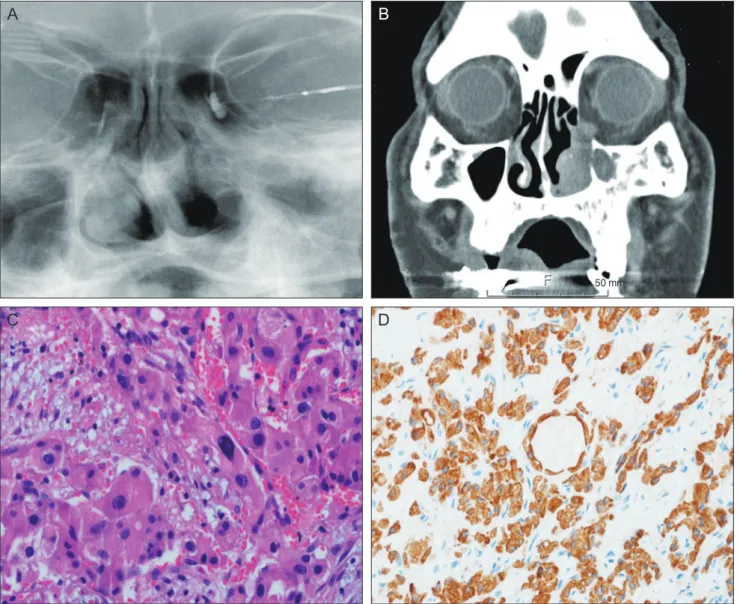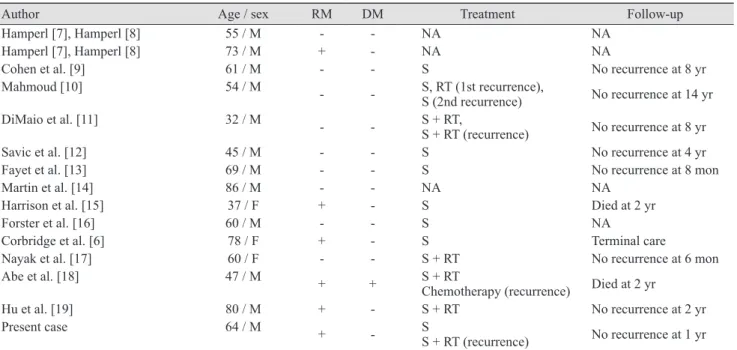Ophthalmic and otolaryngology examination revealed a left lacrimal duct obstruction caused by a mass in the left nasal cavity and lacrimal drainage system
전체 글
(2) JH Jung, et al. Oncocytic Carcinoma in Lacrimal Duct. A. B. 50 mm. C. D. Fig. 1. (A) Left dacryocystography demonstrates nasolacrimal duct obstruction. (B) Computed tomography revealed that the tumor in the left nasal cavity extended to the nasolacrimal duct and sac, and that the mass did not extend into the orbit. (C) Histological examination of the tumor revealed an oncocytic carcinoma; a destructive, infiltrating pattern and tumor cells composed of eccentrically located nuclei with abundant eosinophilic cytoplasm (hematoxylin-eosin, ×400). (D) Pancytokeratin is strongly positive in tumor cells.. was recommended to the patient after surgery, but the patient refused further treatment. Nine months after surgery, the patient complained of purulent discharge with tearing, swelling, and tenderness in the medial canthal area of the left eye. An orbital CT revealed a mass in the medial orbital wall (Fig. 2A). The orbital mass was removed through an inferior transconjunctival approach, and histological examination confirmed oncocytic carcinoma recurrence (Fig. 2B). The patient was referred for adjuvant radiotherapy to eradicate any residual tumor. He received computer controlled radiation therapy as 60 Gy in 33 fractions over 8 weeks. The patient remains free of tumor recurrence after 1 year.. Discussion Although a neoplastic acquired nasolacrimal duct obstruction is an unusual condition, most of these tumors (75% to 90%) are malignant [2]. Clinically, the presence of some specific signs, such as bloody reflux, epistaxis, failure of dacryocystorhinostomy, and a palpable mass above the medial canthal tendon, are helpful for diagnosing tumors of the lacrimal sac and nasolacrimal duct. A history of malignancy, especially of sinus or nasopharyngeal origin, also warrants further investigation into this unusual situation. However, a neoplasm should be considered in any patient presenting with nasolacrimal duct obstruction, and the most essential element in the early diagnosis and initiation 127.
(3) Korean J Ophthalmol Vol.27, No.2, 2013. A. B. Fig. 2. (A) Orbital computed tomography demonstrated an orbital mass located in the medial wall of the left orbit. (B) The recurrent tumor demonstrates the same morphology as the original tumor. The recurrent tumor is also composed of oncocytic epithelial cells with abundant eosinophilic cytoplasm (hematoxylin-eosin, ×400).. Table 1. Reports of oncocytic carcinoma in the nasal cavity Author Hamperl [7], Hamperl [8] Hamperl [7], Hamperl [8] Cohen et al. [9] Mahmoud [10]. Age / sex 55 / M 73 / M 61 / M 54 / M. RM + -. Treatment NA NA S S, RT (1st recurrence), S (2nd recurrence) DiMaio et al. [11] 32 / M S + RT, S + RT (recurrence) Savic et al. [12] 45 / M S Fayet et al. [13] 69 / M S Martin et al. [14] 86 / M NA Harrison et al. [15] 37 / F + S Forster et al. [16] 60 / M S Corbridge et al. [6] 78 / F + S Nayak et al. [17] 60 / F S + RT Abe et al. [18] 47 / M S + RT + + Chemotherapy (recurrence) Hu et al. [19] 80 / M + S + RT Present case 64 / M S + S + RT (recurrence) RM = regional metastasis; DM = distance metastasis; NA = not available; S = surgery; RT = radiotherapy.. of treatment is awareness of these rare clinical features. An oncocytic neoplasm is characterized by abundant, granular and eosinophilic cytoplasm, due to increased numbers of mitochondria, which are the most characteristic features of an oncocyte [1,3]. Diagnosis of malignancy in oncocytomas depends on the criteria defined by Gray et al. [4] destructive, infiltrating growth; cellular pleomorphism with scattered mitoses; lymphovascular or perineu128. DM -. Follow-up NA NA No recurrence at 8 yr No recurrence at 14 yr No recurrence at 8 yr No recurrence at 4 yr No recurrence at 8 mon NA Died at 2 yr NA Terminal care No recurrence at 6 mon Died at 2 yr No recurrence at 2 yr No recurrence at 1 yr. ral invasion; regional or distant metastasis. Most of these carcinomas develop de novo, although malignant transformations of preexisting oncocytomas after long intervals have been reported [5]. The majority of oncocytic tumors in the head and neck arise in the parotid gland, though they can arise in the minor salivary and seromucous glands [3,5,6]. We assumed that the tumor in the current patient originated from a.
(4) JH Jung, et al. Oncocytic Carcinoma in Lacrimal Duct. seromucous gland in the sinonasal tract, and enlarged and invaded into the nasolacrimal duct and sac. A malignant oncocytoma is a rare tumor of the head and neck; approximately 60 cases of oncocytic carcinomas have been reported to date and the majority of these involved the major salivary gland [1,3]. A nasal cavity oncocytic carcinoma is an extremely rare condition. To our knowledge, 14 cases of oncocytic carcinoma arising in the nasal cavity have been reported, and details of previous reports and the current case are given in Table 1. Oncocytic carcinomas in the head and neck are a high grade neoplasm and appear aggressive from the onset: almost 85% of oncocytic carcinomas develop regional or distant metastases and 32% develop local recurrence [3]. Wide, complete local excision is the treatment of choice, and adjuvant radiation therapy should be strongly considered to prevent recurrence. Due to the rarity of these tumors affecting nasal cavity and nasolacrimal duct, the pattern of clinical behavior and long-term follow-up is difficult to predict. However, postoperative radiation therapy has been demonstrated to reduce local recurrence rates in parotid gland malignancies and previous case reports [3,17,19]. We hypothesize that delayed radiotherapy may explain the local recurrence in the present patient. Although tumors of the lacrimal sac and nasolacrimal duct are rare, physicians must consider the possibility of lacrimal sac tumors, nasolacrimal duct tumors, or other nasal cavity pathology, such as an oncocytic carcinoma, whenever symptoms are not typical.. Conflict of Interest No potential conflict of interest relevant to this article was reported.. 3.. 4. 5. 6. 7. 8. 9. 10. 11. 12. 13. 14. 15. 16. 17. 18.. References 1. Wakely PE Jr. Oncocytic and oncocyte-like lesions of the head and neck. Ann Diagn Pathol 2008;12:222-30. 2. Anderson NG, Wojno TH, Grossniklaus HE. Clinicopatho-. 19.. logic findings from lacrimal sac biopsy specimens obtained during dacryocystorhinostomy. Ophthal Plast Reconstr Surg 2003;19:173-6. Gnepp DR, Henley JD, Roderick HW. Salivary and lacrimal glands: oncocytic lesions and tumors. In: Gnepp DR, editor. Diagnostic surgical pathology of the head and neck. Philadelphia: Saunders Elsevier; 2009. p. 413-561. Gray SR, Cornog JL Jr, Seo IS. Oncocytic neoplasms of salivary glands: a report of fifteen cases including two malignant oncocytomas. Cancer 1976;38:1306-17. Nakada M, Nishizaki K, Akagi H, et al. Oncocytic carcinoma of the submandibular gland: a case report and literature review. J Oral Pathol Med 1998;27:225-8. Corbridge RJ, Gallimore AP, Dalton CG, O’Flynn PE. Oncocytomas of the upper jaw. Head Neck 1996;18:374-80. Hamperl H. Benign and malignant oncocytoma. Cancer 1962;15:1019-27. Hamperl H. Onkocytoma of the salivar y glands. Z Krebsforsch 1962;64:427-40. Cohen MA, Batsakis JG. Oncocytic tumors (oncocytomas) of minor salivary glands. Arch Otolaryngol 1968;88:71-3. Mahmoud NA. Malignant oncocytoma of the nasal cavity. J Laryngol Otol 1979;93:729-34. DiMaio SJ, DiMaio VJ, DiMaio TM, et al. Oncocytic carcinoma of the nasal cavity. South Med J 1980;73:803-6. Savic D, Djeric D, Jasovic A. Oncocytoma of the nose and ethmoidal and sphenoidal sinuses. Rev Laryngol Otol Rhinol (Bord) 1989;110:481-3. Fayet B, Bernard JA, Zachar D, et al. Malignant nasal oncocytoma disclosed by mucocele of the lacrimal sac with hemolacrimia. J Fr Ophtalmol 1990;13:153-8. Martin H, Janda J, Behrbohm H. Locally invasive oncocytoma of the nasal cavity. Zentralbl Allg Pathol 1990;136:703-6. Harrison DF, Lund VJ. Tumours of the upper jaw. Edinburgh: Churchill Livingstone; 1993. p. 108. Forster C, Ostertag H. Oncocytoma of the nose: a case report and review of the literature. Pathologe 1995;16:431-3. Nayak DR, Pillai S, Balakrishnan R, et al. Malignant oncocytoma of the nasal cavity: a case report. Am J Otolaryngol 1999;20:323-7. Abe T, Murakami A, Nakajima N, et al. Oncocytic carcinoma of the nasal cavity with widespread lymph node metastases. Auris Nasus Larynx 2007;34:393-6. Hu YW, Lin CZ, Li WY, et al. Locally advanced oncocytic carcinoma of the nasal cavity treated with surgery and intensity-modulated radiotherapy. J Chin Med Assoc 2010;73:166-72.. 129.
(5)
수치


관련 문서
There are a lot of institutions for evaluation in the world, for example, Legislative Evaluation in the Continental Legal System, Regulatory Impact Analysis
Table 2. Schatzker and Lambert assessment --- 18.. A), B) Preoperative anteroposterior and lateral radiograph of the left knee of a sixty-two-year-old man who
Sizes of left and right pupils Intensities of left and right pupils Ellipse ratios of left and right
In Germany, and other European nations, a legislation evaluation system is implemented in order to prove the inevitable enactment of laws or the necessity
Early advancements using chemical principles (Mass Transfer & Polymer Materials).. Nasal sprays that deliver finely atomized amounts of a
As a result, in order to form a cooperation system for the regulation of shipment and production by structuring a network centering on Zakmokban
When a symmetry operation has a locus, that is a point, or a line, or a plane that is left unchanged by the operation, this locus is referred to as the symmetry
* When a symmetry operation has a locus, that is a point, or a line, or a plane that is left unchanged by the operation, this locus is referred to as the symmetry element..